UPES B.Tech Admissions 2026
Ranked #43 among Engineering colleges in India by NIRF | Highest Package 1.3 CR , 100% Placements
The Joint Entrance Examination (JEE) Main is conducted by the National Testing Agency (NTA), and every year, lakhs of students appear for the exam. It is the entrance test – or the preliminary selection round – for the top engineering colleges in the country including the Indian Institutes of Technology (IIT), National Institutes of Technology (NIT), Indian Institutes of Information Technology (IIIT) and many more government institutions.

Clearly, JEE Main is critical. However, JEE Main 2021 had questions which were conceptually or factually ambiguous and some of them were simply incorrect, going by the JEE Main answer key. Last year, the exam was conducted in four phases – February, March, July and August – across 26 Shifts. The result was declared in September.
Here, Careers360 looks into the questions asked in the July and August shifts, and highlights some of the errors in the JEE Main previous year question paper’s Chemistry section. The necessary changes required for these questions were absent from the NTA JEE Main answer keys, which could have affected the scorecards of many candidates in the JEE Main result.
These questions, along with their respective problems, are listed out below:
Question ID : 86435117255
JEE Main Answer Key: 172

The issue:
The unit in which Kp is to be reported has not been specified in the question.
So, a student solving for the unit as (Pa)-1 will get an answer of 0.172 which would be rounded off to 0 while the given answer will be in units of (kPa)-1
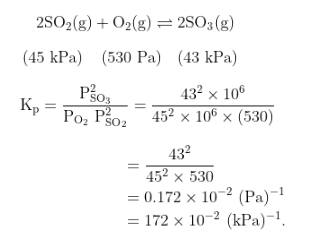
____________________________________________________________________________
Question ID : 86435117528
JEE Main Answer Key: 1

The issue:
There is a conceptual error in the question. A negatively-charged sol cannot be precipitated by a negatively-charged ion.
Also, the coagulating value is defined as the minimum concentration of an electrolyte in millimoles per litre required to cause precipitation of a sol in two hours.
So, there arises another problem: How do you extrapolate data for two hours from the one-hour data?
____________________________________________________________________________
Question ID : 86435117785
JEE Main Answer Key: 86435159952 (Option 2)
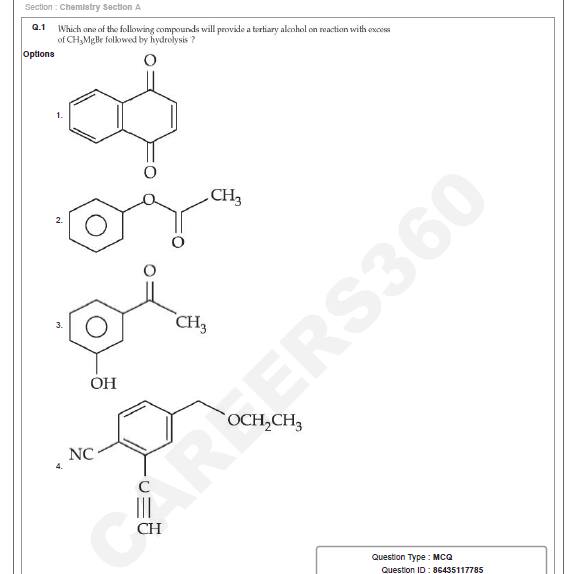
Question and Option IDs
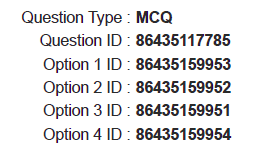
The issue:
Multiple options given in the question (Options 1,2 and 3) are capable of forming tertiary alcohol on reaction with excess of Grignard reagent (CH3MgBr) followed by hydrolysis.
Option 1: Alpha- Beta unsaturated carbonyl compounds show direct addition to the carbonyl group with Grignard reagent. Hence, tertiary alcohols will be obtained from the carbonyl groups
Option 3: Grignard reagent can add to a ketone, forming a tertiary alcohol.
____________________________________________________________________________
Question ID : 86435118234
JEE Main Answer Key: 86435161299 (Option 1)
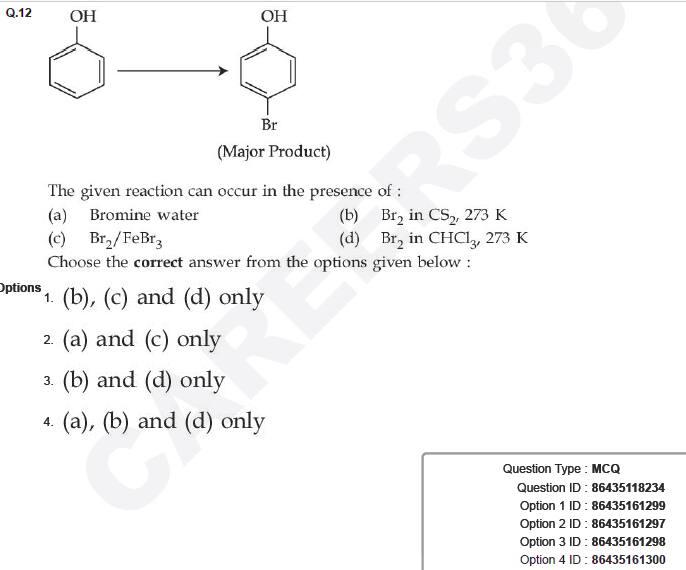
The issue:
Lewis acids are not used with Phenol because Phenol itself forms a complex with the Lewis acid, due to which the ring becomes deactivated towards Electrophilic Substitution.
In fact, this reaction of Phenol with a Lewis acid FeCl3 is actually used to detect the presence of Phenol in solution. Phenol forms a complex with neutral FeCl3 and produces a violet colour.
Correct answer should be 86435161298 [Option (3)]
____________________________________________________________________________
Question ID : 86435118225
JEE Main Answer Key: 86435161264 (Option 3)
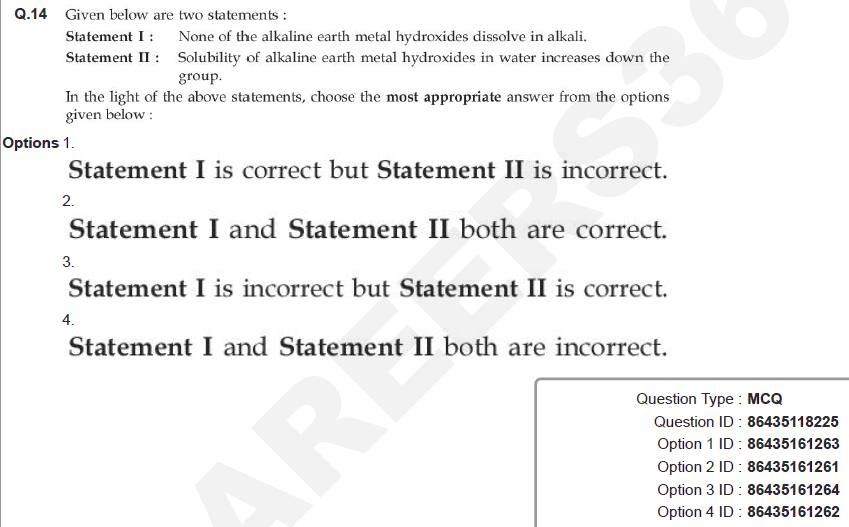
The issue:
Be is not an alkaline earth metal as its oxide and hydroxide are Amphoteric in nature.
Here is an excerpt from NCERT textbook’s chapter on the s Block elements confirming it.

Hence, Statement I is also correct in the given question.
Correct answer should be 86435161261 [Option (2)]
____________________________________________________________________________
Question ID : 86435118870
JEE Main Answer Key: 5

The issue:
Data given is insufficient to solve the problem.
Molality (m) can be calculated from the density of solution only when the Molarity (M) is also given in the question.
In the question, Molarity has not been provided and thus the question cannot be solved.
____________________________________________________________________________
Question ID : 86435119236
JEE Main Answer Key: 300
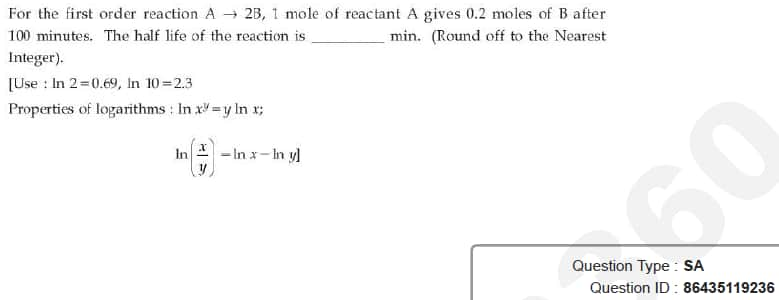
The issue :
The answer in the JEE Main final answer key was wrong. The answer should have been 600.
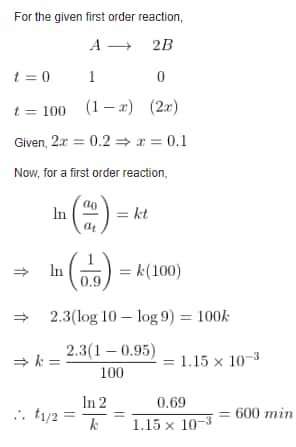
____________________________________________________________________________
Question ID : 86435120226
JEE Main Answer Key: 50
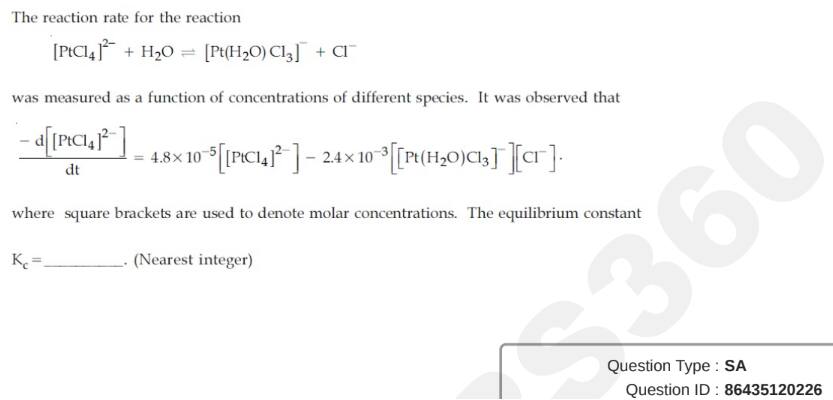
The issue :
The answer given in the answer key is wrong. The answer should be 0.
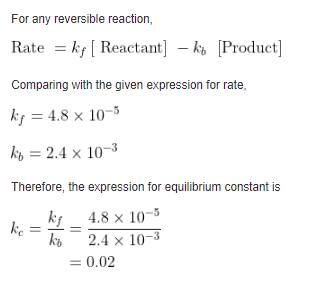
The answer is 0.02 which would be rounded off to 0.
For the answer to be 50, the value of (Kc)-1 had to be asked.
____________________________________________________________________________
Question ID : 86435120586
JEE Main Answer Key: 4

The issue :
The answer given is 4 because the inner 4f electrons have not been counted.
The question does not say that we need to consider only the 5f electrons
____________________________________________________________________________
Question ID : 86435121290
JEE Main Answer Key: 86435170463 (Option 4)
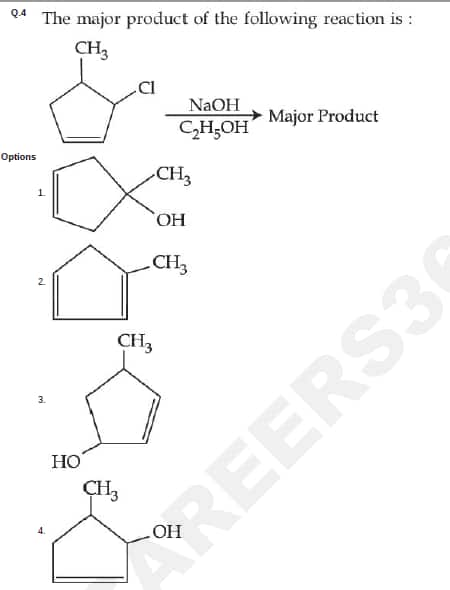
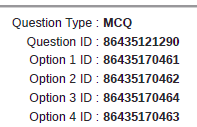
The issue :
Alcoholic NaOH causes dehydrohalogenation (elimination) and not substitution.
The answer should be 86435170462 (Option 2)
____________________________________________________________________________
Question ID : 86435121287
JEE Main Answer Key: 86435170452 (Option 2)
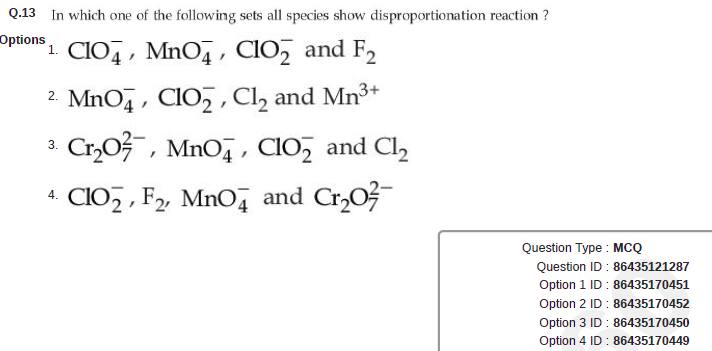
The issue :
None of the options is correct.
All the given options contain permanganate ion (MnO4-) which contains Mn in its highest oxidation state (+7) and hence, it cannot show disproportionation reaction
Question should have been awarded as bonus
____________________________________________________________________________
Question ID : 86435121562
JEE Main Answer Key: 86435171281 (Option 4)
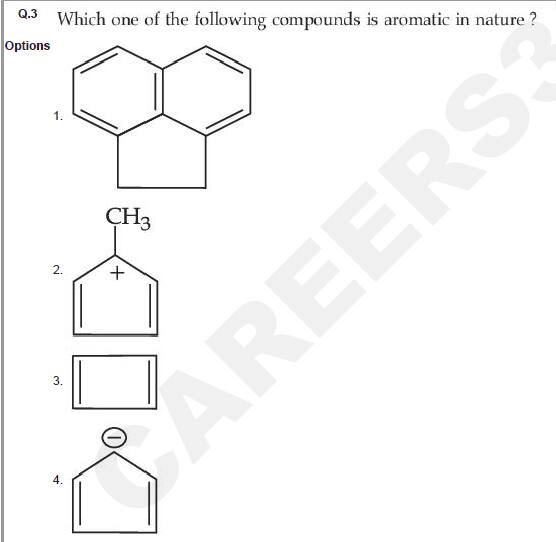
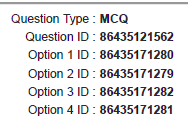
The issue :
Options 1 and 4 can both be correct but only Option 4 has been given as the correct answer.
Acenaphthene (compound in Option 1) is also Aromatic in nature.
____________________________________________________________________________
Apart from the above-mentioned questions, there were also some in the integer section that had very lengthy mathematical calculations and whose answers had to be rounded off to the nearest integers.
These questions are usually solved by approximations and it is very difficult for students to arrive at the correct integer answer. Previously, these questions had a correct range for the answer, which gave students some leeway to make appropriate approximations in calculations.
Now, with negative marking in the numerical response questions, this becomes an even bigger problem. Considering the high-stakes nature of the JEE Mains, even a few such errors can have significant ramifications for applicants and be deeply demoralising.
On Question asked by student community
Hello aspirant
JEE Main accepts NIOS, so you can appear if you meet the basic eligibility.
BITS does not accept marks from two different boards, so this option won’t work for BITS.
VIT and SRM generally accept NIOS, but having two separate mark sheets can be an issue. You should check their official eligibility rules before applying.
Thankyou I hope this help
Hello,
Here are some Government colleges that generally do not require 75% CBSE board criteria for admission through JEE mains based or university counselling.
I hope it will help you. Kindly check the latest eligibility rules for the specific year.
Thank you.
Hello
If you want to get admission in IIT Delhi, then you will score well in JEE Advanced. Only the JEE Mains score is not sufficient to get admission in the IIT Delhi. You need to score 250+ marks for the general category in CSE. For the reservation category, you also need to score much higher marks and give your best performance. If you score quite well in JEE Advanced, then you will have a chance to get admission through JOSAA counselling.
Thank you
To score good marks in JEE Mains, you need a strong plan, consistent study habits and smart practice. First, finish the entire JEE syllabus from NCERT Class 11 and 12 textbooks, because these are the foundation for questions asked in the exam. After completing the basics, choose good quality reference books for Physics, Chemistry and Mathematics to build problem-solving skills and deepen your understanding. Make a weekly study plan where each day is divided into theory study, problem practice and revision of earlier topics.
Regularly solve previous years’ JEE Main papers and take timed mock tests to improve your speed and accuracy. Analyse every test you take, understand your mistakes and work on weak areas instead of only doing new questions. In subjects like Physics and Mathematics, practising a variety of numerical problems is important, while in Chemistry focus on concepts and reactions that are frequently asked. Revision is crucial, so dedicate time every week to revisit older topics and short notes that you make while preparing.
Stay consistent, avoid last-minute cramming, and maintain good health with adequate sleep and breaks during study. With disciplined planning, regular practice and careful revision, you can significantly improve your JEE Main score. All the best.
Achieving a JEE Rank of below 100 in JEE Main and Advanced 2027 requires a disciplined, two-year preparation strategy starting from Class 11. Your study plan must integrate competitive exam preparation with your school academics:
Syllabus Completion: Dedicate this year to rigorously completing the entire Class 11 NCERT syllabus for Physics, Chemistry, and Mathematics (PCM). Focus heavily on fundamental topics like Mechanics (Physics), General Organic Chemistry (GOC) and Chemical Bonding (Chemistry), and Calculus basics (Maths).
Concept Mastery: Do not rush. Master concepts thoroughly before moving to problems. Use standard JEE reference books and ensure you solve all NCERT examples and exercises first.
Practice: Allocate 60% of your study time to concept building and 40% to problem-solving. Practice JEE Main Previous Year Questions (PYQs) immediately after completing a chapter to gauge the exam pattern.
Advanced Topics: Complete the Class 12 syllabus by November 2026, focusing on high-weightage topics like Electrostatics, Modern Physics, and Electrochemistry.
Revision & Mocks: Reserve the period from December 2026 to January 2027 solely for mock tests and revision. Start taking full-length JEE Main mock tests (3 per week) under strict timed conditions. Analyze each mock test thoroughly to eliminate repeated errors.
Target JEE Advanced: After the JEE Main attempts in early 2027, shift focus entirely to JEE Advanced PYQs and challenging, multi-concept problems, taking at least 2 JEE Advanced mock tests per week.
A detailed subject-wise study plan and additional tips on effective JEE preparation starting from Class 11 can be found here: https://engineering.careers360.com/articles/jee-preparation-from-class-11
Among top 100 Universities Globally in the Times Higher Education (THE) Interdisciplinary Science Rankings 2026
Ranked #43 among Engineering colleges in India by NIRF | Highest Package 1.3 CR , 100% Placements
National level exam conducted by VIT University, Vellore | Ranked #16 by NIRF for Engg. | NAAC A++ Accredited
Recognized as Institute of Eminence by Govt. of India | NAAC ‘A++’ Grade | Upto 75% Scholarships
#6 All India Rank- IIRF Impact Ranking 2025 | H-CTC 24 LPA | Merit-Based Scholarships | Best of 2 Scores Advantage
Hands on Mentoring and Code Coaching | Cutting Edge Curriculum with Real World Application